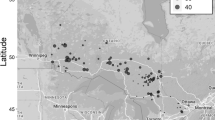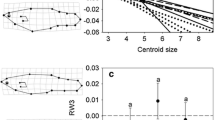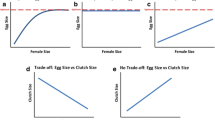Abstract
The dwarf morph of the Lake Tanganyika cichlid Telmatochromis temporalis uses empty snail shells as shelters and breeding sites in shell beds, in which many empty shells exist. Here, we assessed selection forces regulating body size in this fish. Field observations showed that large males tended to have a greater number of females in their territories, suggesting that sexual selection favours large males. Nonetheless, a transplant experiment suggested that male body size was limited by the ability to hide in empty shells from large piscivorous fish. In females, the number of ovarian eggs increased with body size, suggesting that fecundity selection favours large females. However, females are smaller than males. Females spawned eggs close to the apices inside the shells. The small space there would decrease the risk of egg predation by egg predators, and small body size of females may be a result of adaptation to spawn eggs in the small, safe spaces. This study provides support for the idea that male and female body sizes have been limited by different ecological pressures (predation on adult fish in males, predation on eggs in females), which has not been reported previously in any animal.





Similar content being viewed by others
References
Blanckenhorn, W. U., 2000. The evolution of body size: what keeps organisms small? Quarterly Review of Biology 75: 385–407.
Blanckenhorn, W. U., 2005. Behavioral causes and consequences of sexual size dimorphism. Ethology 111: 977–1016.
Bolnick, D. I. & M. Doebeli, 2003. Sexual dimorphism and adaptive speciation: two sides of the same ecological coin. Evolution 57: 2433–2449.
Cumberlidge, N., R. Von Sternberg, I. R. Bills & H. Martin, 1999. A revision of the genus Platythelphusa A. Milne-Edwards, 1887 from Lake Tanganyika, East Africa (Decapoda: Potamoidea: Platythelphusidae). Journal of Natural History 33: 1487–1512.
Demment, M. W. & P. J. Van Soest, 1985. A nutritional explanation for body-size patterns of ruminant and nonruminant herbivores. The American Naturalist 125: 641–672.
Elgar, M. A., 1990. Evolutionary compromise between a few large and many small eggs: comparative evidence in teleost fish. Oikos 59: 283–287.
Erlinge, S., 1987. Why do European stoats Mustela erminae not follow Bergmann’s rule? Holarctic Ecology 10: 33–39.
Forsgren, E., C. Kvarnemo & K. Lindström, 1996. Mode of sexual selection determined by resource abundance in two sand goby populations. Evolution 50: 646–654.
Gliwicz, J., 1988. Sexual dimorphism in small mustelids: body diameter limitation. Oikos 53: 411–414.
Head, G., 1995. Selection on fecundity and variation in the degree of sexual size dimorphism among spider species (class Araneae). Evolution 49: 776–781.
Hedrick, A. V. & E. J. Temeles, 1989. The evolution of sexual dimorphism in animals: hypotheses and tests. Trends in Ecology and Evolution 4: 136–138.
Hendry, A. P., M. L. Kelly, M. T. Kinnison & D. N. Reznick, 2006. Parallel evolution of the sexes? Effects of predation and habitat features on the size and shape of wild guppies. Journal of Evolutionary Biology 19: 741–754.
Heske, E. J. & R. S. Ostfeld, 1990. Sexual dimorphism in size, relative size of testes, and mating systems in North American voles. Journal of Mammalogy 71: 510–519.
Hori, M., 1997. Structure of littoral fish communities organized by their feeding activities. In Kawanabe, H., M. Hori & M. Nagoshi (eds), Fish Communities in Lake Tanganyika. Kyoto University Press, Kyoto: 275–298.
Hori, M., M. M. Gashagaza, M. Nshombo & H. Kawanabe, 1993. Littoral fish communities in Lake Tanganyika: irreplaceable diversity supported by intricate interactions among species. Conservation Biology 7: 657–666.
Hughes, A. L. & M. K. Hughes, 1986. Paternal investment and sexual size dimorphism in North American Passerines. Oikos 46: 171–175.
Jonsson, B., N. Jonsson, E. Brodtkorb & P.-J. Ingebrigtsen, 2001. Life-history traits of brown trout vary with the size of small streams. Functional Ecology 15: 310–317.
Katoh, R., H. Munehara & M. Kohda, 2005. Alternative male mating tactics of the substrate brooding cichlid Telmatochromis temporalis in Lake Tanganyika. Zoological Science 22: 555–561.
Nakai, K., Y. Yanagisawa, T. Sato, Y. Niimura & M. M. Gashagaza, 1990. Lunar synchronization of spawning in cichlid fishes of the tribe Lamprologini in Lake Tanganyika. Journal of Fish Biology 37: 589–598.
Ott, J. R. & M. Lampo, 1991. Body size selection in Acanthoscelides alboscutellatus (Coleoptera: Bruchidae). Oecologia 87: 522–527.
Pearson, D., R. Shine & R. How, 2002. Sex-specific niche partitioning and sexual size dimorphism in Australian pythons (Morelia spilota imbricata). Biological Journal of the Linnaean Society 77: 113–125.
Peters, R. H. & K. Wassenberg, 1983. The effect of body size on animal abundance. Oecologia 60: 89–96.
Plaistow, S. J., C. T. Lapsley, A. P. Beckerman & T. G. Benton, 2004. Age and size at maturity: sex, environmental variability and developmental thresholds. Proceedings of the Royal Society of London B 271: 919–924.
Poll, M., 1956. Poissons Cichlidae. Résultats scientifiques. Exploration hydrobiologique du Lac Tanganika (1946–1947). Institut Royal des Sciences Naturelles de Belgique 3(5B): 1–619.
Prenter, J., R. W. Elwood & W. I. Montgomery, 1999. Sexual size dimorphism and reproductive investment by female spiders: a comparative analysis. Evolution 53: 1987–1994.
Reznick, D. N. & C. K. Ghalambor, 2005. Can commercial fishing cause evolution? Answers from guppies (Poecilia reticulata). Canadian Journal of Fisheries and Aquatic Sciences 62: 791–801.
Rice, W. R., 1989. Analyzing tables of statistical tests. Evolution 43: 223–225.
Rossiter, A., 1991. Lunar spawning synchroneity in a freshwater fish. Naturwissenschaften 78: 182–184.
Safina, C., 1984. Selection for reduced male size in raptorial birds: the possible roles of female choice and mate guarding. Oikos 43: 159–164.
Sato, T., 1994. Active accumulation of spawning substrate: a determinant of extreme polygyny in a shell-brooding cichlid fish. Animal Behaviour 48: 669–678.
Sato, T. & M. M. Gashagaza, 1997. Shell-broong cichlid fishes of Lake Tanganyika: their habitats and mating systems. In Kawanabe, H., M. Hori & M. Nagoshi (eds), Fish Communities in Lake Tanganyika. Kyoto University Press, Kyoto: 219–240.
Schluter, D., 2000. The Ecology of Adaptive Radiation. Oxford University Press, Oxford.
Schluter, D., T. D. Price & L. Rowe, 1991. Conflicting selection pressures and life history trade-offs. Proceedings of the Royal Society of London B 246: 11–17.
Schütz, D. & M. Taborsky, 2000. Giant males or dwarf females: what determines the extreme sexual size dimorphism in Lamprologus callipterus? Journal of Fish Biology 57: 1254–1265.
Schütz, D. & M. Taborsky, 2005. The influence of sexual selection and ecological constraints on an extreme sexual size dimorphism in a cichlid. Animal Behaviour 70: 539–549.
Schütz, D., G. A. Parker, M. Taborsky & T. Sato, 2006. An optimality approach to male and female body sizes in an extremely size-dimorphic cichlid fish. Evolutionary Ecology Research 8: 1–16.
Shetty, S. & R. Shine, 2002. Sexual divergence in diets and morphology in Fijian sea snakes Laticauda colubrina (Laticaudinae). Austral Ecology 27: 77–84.
Simms, D. A., 1979. North American weasels: resource utilization and distribution. Canadian Journal of Zoology 57: 504–520.
Sokal, R. R. & F. J. Rohlf, 1995. Biometry, 3rd ed. Freeman, New York.
Stearns, S. C., 1992. The Evolution of Life Histories. Oxford University Press, Oxford.
Stearns, S. C., M. Ackermann, M. Doebeli & M. Kaiser, 2000. Experimental evolution of aging, growth, and reproduction in fruitflies. Proceedings of the National Academy of Sciences of the United States of America 97: 3309–3313.
Székely, T., J. D. Reynolds & J. Figuerola, 2000. Sexual size dimorphism in shorebirds, gulls, and alcids: the influence of sexual and natural selection. Evolution 54: 1404–1413.
Takahashi, T., 2003. Systematics of Tanganyikan cichlid fishes (Teleostei: Perciformes). Ichthyological Research 50: 367–382.
Takahashi, T., 2004. Morphological and genetic distinctness of rock and shell-bed dwelling Telmatochromis (Teleostei, Cichlidae) in the south of Lake Tanganyika suggest the existence of two species. Journal of Fish Biology 65: 419–435.
Takahashi, T., 2010. Different degrees of lunar synchronization of ovary development between two morphs of a Tanganyika cichlid fish. Hydrobiologia 644: 139–143.
Takahashi, T., K. Watanabe, H. Munehara, L. Rüber & M. Hori, 2009. Evidence for divergent natural selection of a Lake Tanganyika cichlid inferred from repeated radiations in body size. Molecular Ecology 18: 3110–3119.
Temeles, E. J., I. L. Pan, J. L. Brennan & J. N. Horwitt, 2000. Evidence for ecological causation of sexual dimorphism in a hummingbird. Science 298: 441–443.
Tobler, M., I. Schlupp & M. Plath, 2008. Does divergence in female mate choice affect male size distributions in two cave fish populations? Biology Letters 4: 452–454.
Tracy, C. R., 1999. Differences in body size among chuckwalla (Sauromalus obesus) populations. Ecology 80: 259–271.
Uhl, G., S. Schmitt, M. A. Schaefer & W. Blanckenhorn, 2004. Food and sex-specific growth strategies in a spider. Evolutionary Ecology Research 6: 523–540.
Walsh, M. R. & D. N. Reznick, 2008. Interactions between the direct and indirect effects of predators determine life history evolution in a killifish. Proceedings of the National Academy of Sciences of the United States of America 105: 594–599.
Wapstra, E., R. Swain & J. M. O’Reilly, 2001. Geographic variation in age and size at maturity in a small Australian viviparous skink. Copeia 2001: 646–655.
Webster, M. S., 1992. Sexual dimorphism, mating system and body size in new world blackbirds (Icterinae). Evolution 46: 1621–1641.
Acknowledgements
We thank H. Phiri, D. Sinynza, and the other staff of the Lake Tanganyika Research Unit in Mpulungu for support in the field; T. Komai for identifying crab species; E. Nakajima and D. Sinynza for providing language help; T. Sota, Y. Takami and H. Toju for advice on research. This study was supported by Grants-in-Aid for JSPS Fellows (No. 20188), for Special Purposes (No. 18779002), for Young Scientists (No. 20770065), and Scientific Research (No. 23370043) to TT, Grant-in-Aid for Scientific Research (No. 22405010) to MK, and Global COE Program (A06) to Kyoto University.
Author information
Authors and Affiliations
Corresponding author
Additional information
Handling editor: Christian Sturmbauer
Rights and permissions
About this article
Cite this article
Takahashi, T., Ota, K., Kohda, M. et al. Some evidence for different ecological pressures that constrain male and female body size. Hydrobiologia 684, 35–44 (2012). https://doi.org/10.1007/s10750-011-0961-4
Received:
Revised:
Accepted:
Published:
Issue Date:
DOI: https://doi.org/10.1007/s10750-011-0961-4




